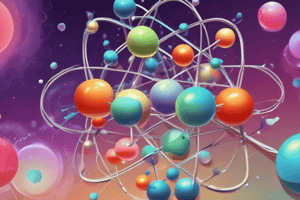Podcast
Questions and Answers
What type of bond forms through sharing electrons?
What type of bond forms through sharing electrons?
- Metallic
- Polar
- Ionic
- Covalent (correct)
What distinguishes the properties of diamond and graphite despite both being composed of carbon atoms?
What distinguishes the properties of diamond and graphite despite both being composed of carbon atoms?
- Atomic number
- Atomic weight
- Atomic radius
- Atomic arrangement (correct)
Which industry heavily relies on inorganic chemistry for the production of metal alloys?
Which industry heavily relies on inorganic chemistry for the production of metal alloys?
- Textile
- Agriculture
- Automotive (correct)
- Construction
What types of materials offer high tensile strength, toughness, and exceptional heat resistance?
What types of materials offer high tensile strength, toughness, and exceptional heat resistance?
Which field benefits significantly from inorganic chemistry due to the reliance on semiconductors?
Which field benefits significantly from inorganic chemistry due to the reliance on semiconductors?
Why is understanding inorganic chemistry important as technology evolves?
Why is understanding inorganic chemistry important as technology evolves?
Which branch of chemistry focuses on carbon-centered molecules found in living organisms?
Which branch of chemistry focuses on carbon-centered molecules found in living organisms?
Which of the following is NOT an element commonly found in homes?
Which of the following is NOT an element commonly found in homes?
What type of bonds occur when electropositive metals lose electrons and electronegative nonmetals gain electrons?
What type of bonds occur when electropositive metals lose electrons and electronegative nonmetals gain electrons?
In inorganic chemistry, compounds like table salt (NaCl) are held together by what type of attraction?
In inorganic chemistry, compounds like table salt (NaCl) are held together by what type of attraction?
Which type of chemistry deals with atoms, their electrons, and the formation of stable molecular compounds?
Which type of chemistry deals with atoms, their electrons, and the formation of stable molecular compounds?
What gives rise to cations and anions in ionic compounds?
What gives rise to cations and anions in ionic compounds?
Flashcards are hidden until you start studying
Study Notes
Exploring Inorganic Chemistry's Fascinating World
Inorganic chemistry is one of two primary branches within this vast field we call chemistry—the other being organic chemistry. While organic chemistry focuses on carbon-centered molecules found predominantly in living organisms, inorganic chemistry dives into everything else under our sun. From metal elements like gold and copper to compounds containing nitrogen such as ammonia and nitric acid, inorganic chemistry paints a colorful landscape teeming with life's essential building blocks.
Atoms & Elements
At its core, inorganic chemistry revolves around atoms, their electrons, and how they bond together to form stable structures known as molecular compounds. These atoms come from what we refer to as chemical elements—substances that cannot be broken down into simpler materials by ordinary means. Some well-known examples of elements you might find in your own home include aluminum (Al), calcium (Ca), chlorine (Cl), hydrogen (H), oxygen (O), phosphorus (P), sodium (Na), and sulfur (S).
Bonds & Compounds
The elemental bonds formed between atoms help shape various types of compounds. For instance, ionic bonds occur when electropositive metals lose electrons, forming cations, while electronegative nonmetals gain these electrons, resulting in anions. Ionic compounds, such as table salt (NaCl), consist of oppositely charged ions held together through electrostatic attraction. Another type of bond, called covalent, forms through sharing electrons; compounds made up of shared pairs of electrons are referred to as covalent compounds.
Structures & Properties
When atoms bind together, they create specific arrangements unique to each compound. Understanding these structural relationships allows us to predict a substance's properties accurately. Take, for example, diamond and graphite, both composed primarily of carbon atoms bonded together. However, despite having the same element, their distinct atomic arrangement results in noticeable differences in hardness, conductivity, and hydrophobicity.
Applications & Everyday Life
Inorganic chemistry has far-reaching applications across numerous industries—from medicine and agriculture to electronics and energy production. This branch of science contributes heavily to manufacturing materials used today:
- Metal alloys, employing combinations of different metallic elements, improve mechanical strength, corrosion resistance, thermal stability, etc..
- Ceramics offer high tensile strength, toughness, and exceptional resistance to heat. They have broad applications in engineering, glassmaking, and environmental remediation.
- Semiconductors, crucial components in computer chips and solar panels, rely on precise control over impurities introduced during crystal growth.
As technology evolves, so too does the importance of understanding inorganic chemistry. By exploring the realm of matter beyond our bodies, we can uncover new ways to solve problems impacting society, industry, and humanity alike.
Studying That Suits You
Use AI to generate personalized quizzes and flashcards to suit your learning preferences.




